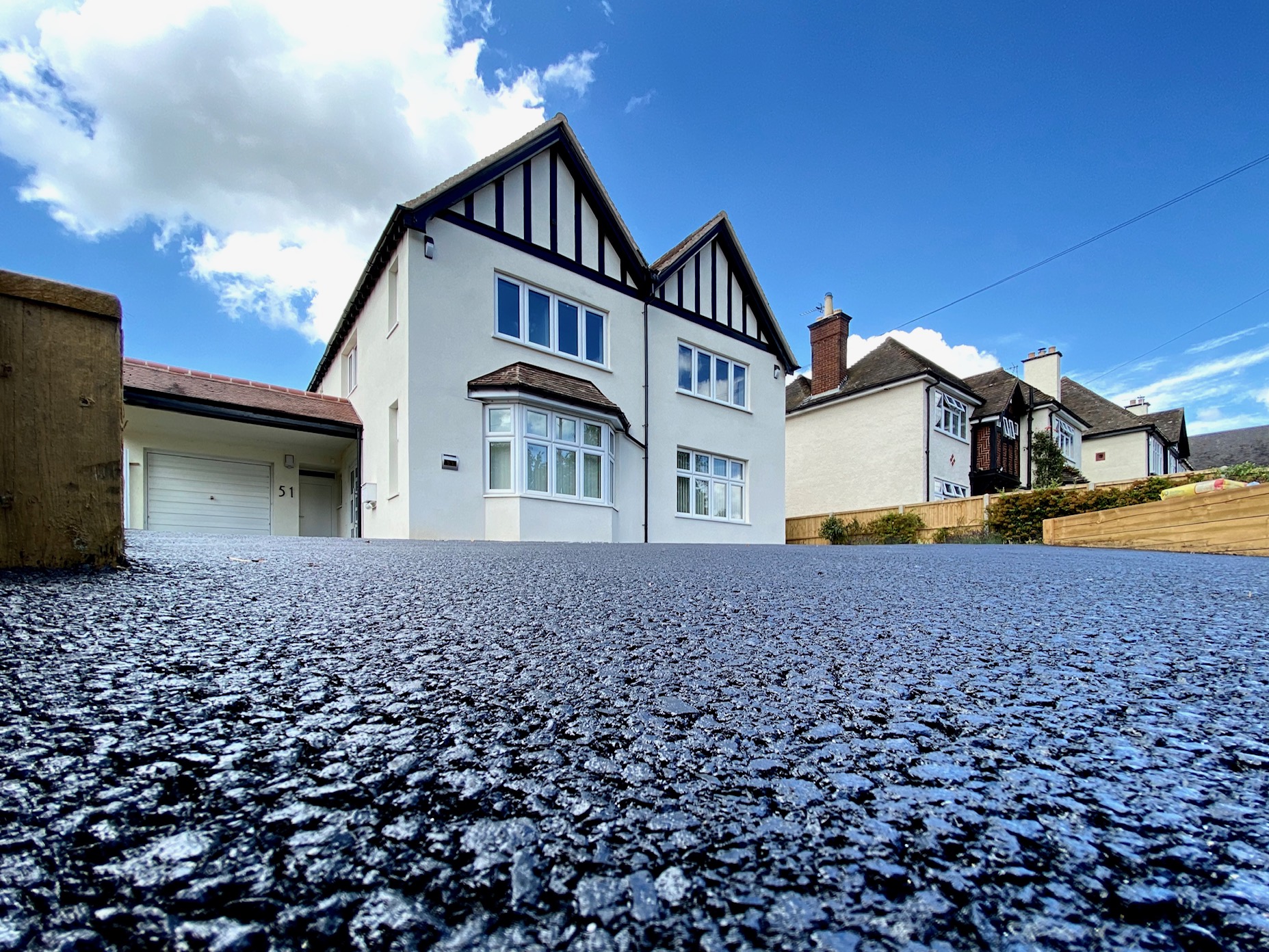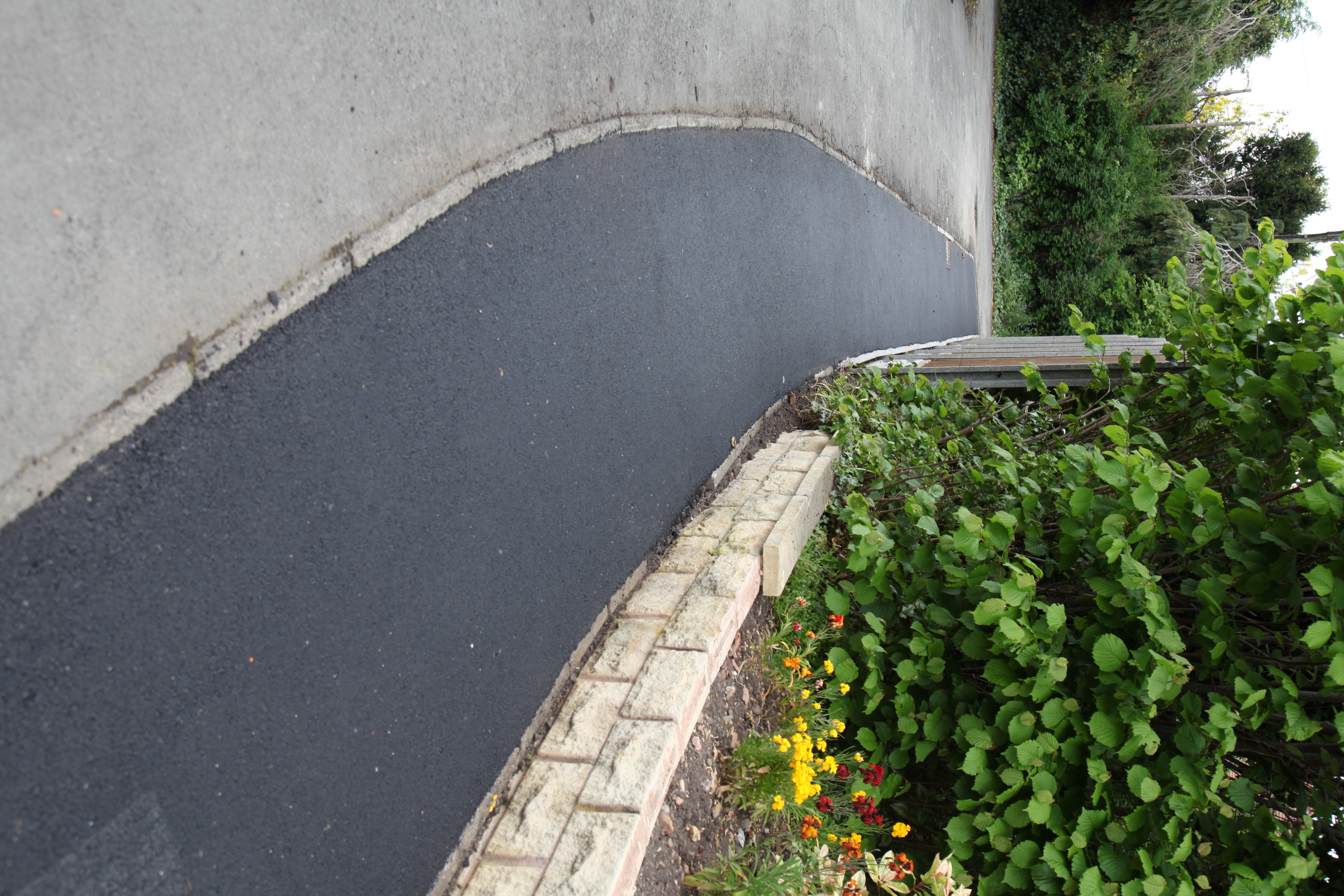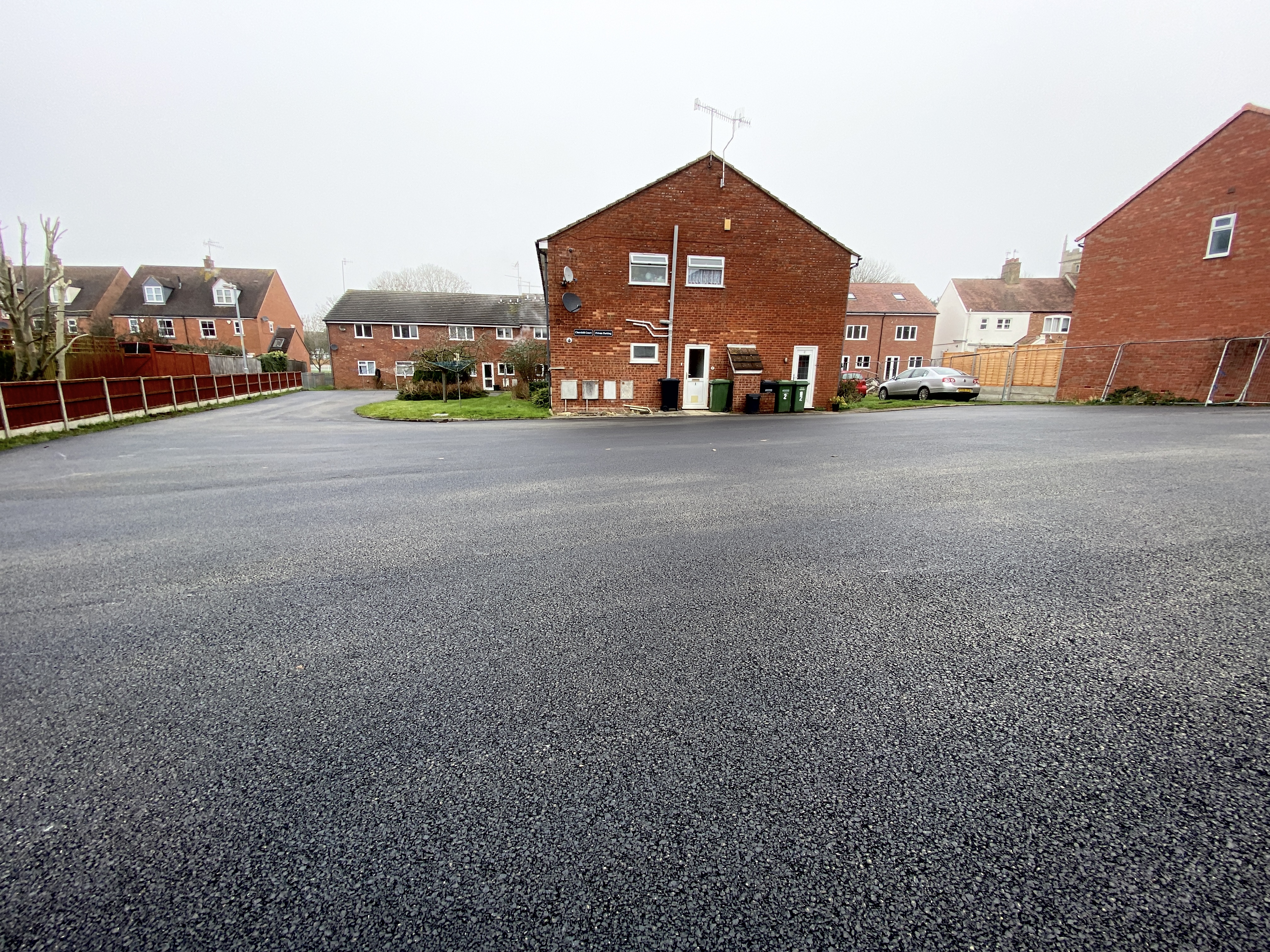
HOW LONG DOES TARMAC TAKE TO DRY?
Blog
Have you ever wanted to understand the drying time of tarmac when installing tarmac driveways? Drying is crucial when it comes to ensuring the durability, safety, and functionality of tarmac driveways and surfaces. Whether it's an existing driveway, a new driveway, road, or other tarmac installation, allowing sufficient drying time is essential to avoid potential damage and accidents.
But how long does tarmac for a tarmac driveway actually take to dry? In this blog post, we will explore the factors that influence the drying process of tarmac and provide an approximate timeframe for its complete drying. Let's dive in and discover the importance of understanding tarmac's drying time.

What is tarmac used for?
Tarmac is widely used for various paved surfaces such as tarmac driveways, roads, parking lots, and pathways. Its versatility, durability, and cost-effectiveness make it a popular choice for both residential and commercial applications.
Whether you're driving on a smooth road, parking your car on a sturdy tarmac driveway, or walking on a well-paved pathway, chances are you're benefiting from the use of tarmac. Its ability to withstand heavy traffic, extreme weather conditions, and regular wear and tear makes it a reliable surfacing option for countless infrastructure projects worldwide.
So, how long does a tarmac driveway take to dry?
After the installation of your tarmac driveway, it is crucial to refrain from parking any vehicles on it for a minimum of 48 hours. In general, you can expect new tarmac to take around two to three days to dry completely.
However, it's important to note that the actual drying time for a tarmac driveway can vary depending on factors such as weather conditions, thickness of the tarmac layer, and humidity levels. It is always best to follow professional recommendations specific to your tarmac driveway or project.
Initially, the tarmac will be in a soft state, and the weight of heavy vehicles can potentially cause sinking or indentations. Allowing sufficient time for the tarmac to properly set and dry over the 48-hour period will help prevent these issues. However, here at Henson Surfacing, we would always recommend waiting at least 5-7 days before heavy traffic flows and parking on your tarmac driveway.

Why does the tarmac need to dry?
When you consider costs with tarmac driveway prices, labour costs and supply costs, it is important to understand how to care for your tarmac driveway after having your driveway installed to avoid any wear and tear.
Allowing sufficient drying time before using or parking on tarmac is of utmost importance to ensure the longevity and integrity of the paved surface. By allowing sufficient drying time for tarmac driveways, moisture can escape from the pavement, ensuring optimal curing. This helps prevent issues such as cracking or premature deterioration.
Understanding the drying process of Tarmac
Now that we have an idea of why it's important to ensure that tarmac has sufficient time to dry - whether it's on pavement, road or driveway, let's take a look at the drying process and how it works.
Tarmac drying involves several stages that contribute to its overall hardening and stability. Here's an overview of the drying process:
- Application: Tarmac is typically applied as a hot mix using specialised machinery. The mixture consists of aggregates (such as crushed stone or sand) and tar, which holds the mixture together.
- Compaction: After the tarmac is applied, it needs to be compacted to remove air voids and achieve the desired density. Compaction helps improve the structural integrity and durability of the tarmac driveway.
- Cooling: As the hot tarmac cools down, it begins to harden and solidify. The cooling process is essential for the tarmac to develop its strength and resistance to deformation.
- Volatile evaporation: During the cooling stage, volatile compounds including light oils and gases that were part of the initial mixture are evaporated. The evaporation of these compounds helps the tarmac become more stable and less susceptible to rutting.
- Curing: Curing is the process by which the tarmac undergoes chemical reactions and physical changes to reach its optimal properties. It involves the gradual hardening of the tarmac. Curing can take several weeks to months, depending on factors like temperature, humidity, and thickness of the layer of the tarmac driveway.
- Full hardening: Over time, the tarmac continues to harden and cure, reaching its maximum strength and stability. This full hardening process may take several months to complete, during which the tarmac becomes fully resistant to traffic loads, weathering, and other external factors.
The Materials and drying time
Tarmac is composed of several key components that work together to create a durable and smooth surface. Let's take a look at them to understand why the drying process is essential.
Aggregate:
Recycled aggregates are a mixture of various crushed rocks, gravel, and sand. These materials provide structural integrity and strength to the tarmac. The size and type of aggregate used can vary depending on the specific application and desired characteristics of the pavement.
Filler:
Fillers, such as limestone dust or hydrated lime, are added to the mixture to improve the workability and stability of the tarmac. They help fill any gaps between aggregate particles, enhancing the overall strength and durability of the tarmac driveway.
Additives:
Various additives may be incorporated into the tarmac mix to enhance specific properties. These additives can include polymers, fibres, or chemicals that improve elasticity, reduce cracking, increase resistance to ageing, or enhance the performance of the tarmac driveway under certain conditions.
Tar:
Tar is a viscous black substance derived from the distillation of coal or petroleum. It is commonly used in various applications, including road construction, roofing, and waterproofing.
When tar is applied to a surface, it undergoes a drying process that is essential for its proper functionality and longevity. Here are a few reasons why it is crucial to let tar dry:
- Curing:
Tar requires time to cure and harden. During the drying process, the volatile components within the tar evaporate, allowing it to solidify and form a stable and durable surface for a tarmac driveway.
- Adhesion:
Allowing tar to dry enables it to establish a strong bond with the surface it is applied to. Whether it is a road, roof, or any other area, the drying time allows the tar to adhere firmly, preventing it from peeling or becoming dislodged. This adhesion is essential for the long-term performance and structural integrity of the application.
- Weather Resistant:
Drying time plays a critical role in enhancing the weather resistance of tar. As the tar dries, it forms a protective barrier against elements such as rain, UV radiation, temperature fluctuations, and chemical exposure. The drying process enables the tar to become more resistant to water penetration, preventing damage caused by water infiltration, such as cracking or weakening of the underlying material.
- Traffic Load:
In the case of roads or tarmac driveways, allowing tar to dry is essential before subjecting it to traffic load. The drying time ensures that the tar has reached its optimal hardness and can withstand the weight and pressure exerted by vehicles. Premature use of freshly applied tar may result in deformation, ruts, or damage to the tarmac driveway.
How weather can affect the drying process
When it comes to the drying of most tarmac driveways, weather conditions play a significant role. Let's take a look at how drying tarmac is affected by different kinds of weather.
Tarmac Drying in Hot Weather
Hot weather conditions can have a significant impact on the drying process of tarmac. The intense heat and sunlight can cause the pavement to crack and fade over time. UV light and high temperatures can also break down and dry out the binding agents in asphalt, making it brittle and prone to breakage. It is crucial to take preventive measures to protect your tarmac driveway or asphalt surfaces during hot weather.
Consider the following tips for tarmac driveway drying in hot weather:
Apply seal coating: Sealants should be applied to tarmac or asphalt surfaces during warm temperatures and plenty of sunshine. This helps to protect the surface from the damaging effects of heat and prevent moisture penetration.
- Regular maintenance: Perform routine inspections and maintenance on your tarmac or asphalt surfaces, especially during hot weather. Fill in any cracks or gaps promptly to prevent them from getting worse.
- Avoid heavy loads and excessive traffic: During hot weather, the tarmac may become softer and more susceptible to damage. Try to avoid parking heavy vehicles or placing heavy objects on the surface to prevent indentation or deformation.
- Provide shade: If possible, create shade over your tarmac driveway or parking lot. This can help reduce direct exposure to the sun, minimising the risk of drying out and cracking.
Tarmac Drying in Cold Weather
Cold weather conditions can also affect the drying process of tarmac. Low temperatures and frost can slow down the curing and hardening of the asphalt. In extremely cold weather, hot mix asphalt may need additional time to cool and set properly.
Consider the following tips for tarmac driveway drying in cold weather:
- Allow for extra drying time: If you're paving or repairing tarmac in cold weather, be prepared for a longer drying time. Cold temperatures can prolong the curing process, so it's important to be patient and allow sufficient time for the tarmac to fully harden.
- Use additives: In colder climates, additives can be mixed with the asphalt to help accelerate the curing process. These additives can improve the flexibility and durability of the tarmac, even in freezing temperatures.
- Protect from freezing: If there is a risk of freezing temperatures shortly after tarmac installation, it's crucial to protect the surface. Covering the freshly laid tarmac with insulating materials or using temporary heating methods can prevent freezing and ensure proper curing.
Tarmac Drying in Rain
Rain can significantly impact the drying process of tarmac, especially if it occurs shortly after installation or repair. Moisture can interfere with the binding agents in the asphalt, making it difficult for the tarmac to properly cure and harden.
Consider the following tips for tarmac driveway drying in the rain:
- Delay paving or repairs: If rain is forecasted, it's advisable to postpone any tarmac paving or repairs. Moisture can prevent the asphalt from setting correctly and may result in poor adhesion and stability.
- Protect the surface: In cases where rain is unexpected or unavoidable, covering the freshly laid tarmac with waterproof materials can help shield it from excess moisture. This can prevent water from seeping into the asphalt and causing damage.
How Thickness of tarmac can affect the drying process
Thicker tarmac layers generally take longer to dry due to several factors that affect the drying process. Here's an explanation of the correlation between thickness and drying time:
Heat Transfer:
During the drying process, heat is required to evaporate the moisture from the hot mix tarmac. Thicker layers of tarmac act as insulation, making it more difficult for heat to penetrate and reach the lower layers. This slower heat transfer impedes the evaporation process, leading to longer drying times.
Moisture Content:
Thicker tarmac layers have a larger volume and therefore contain more moisture within the material. The excess moisture needs to evaporate from the entire thickness of the tarmac, and this requires additional time. The moisture content plays a significant role in determining the overall drying time for a tarmac driveway.
Air Circulation:
Adequate air circulation is crucial for the drying process of a tarmac driveway. Thicker tarmac layers can restrict airflow, especially in the lower layers, which are shielded by the upper layers. Limited air circulation slows down the evaporation rate, prolonging the drying time.
Curing Time:
Thicker tarmac layers may also require a longer curing time. Curing refers to the chemical and physical processes that take place within the tarmac, allowing it to harden and gain strength. The curing process is closely linked to the drying process, and thicker layers generally require more time for complete curing.
Environmental Factors:
Environmental conditions, such as temperature, humidity, and air movement, greatly influence drying time. Thicker tarmac layers are more susceptible to variations in these factors. For example, lower temperatures or higher humidity levels can further prolong drying time for thicker layers as they impede the evaporation process.

Post-installation care
After you have you amazing new tarmac driveway or pathway, there are many ways in which you can make sure it stays in excellent condition. Let's take a look and remind ourselves of the top priority maintenance protocols that need to be taken.
- Allow Sufficient Drying Time: Give the tarmac ample time to dry and cure before subjecting it to heavy traffic or sharp objects.
- Avoid Heavy Traffic: During the initial weeks, minimise heavy traffic or excessive weight on the tarmac.
- Prevent Sharp Objects: Keep sharp objects, such as high heels or pointed tools, away from the tarmac during the curing period. These objects can cause punctures or tears in the surface, compromising its integrity.
- Protect from Water Damage: Minimise exposure to standing water or prolonged moisture during the drying period. Proper drainage and regular inspection of drainage systems can help prevent water-related issues that can affect the tarmac's durability.
Maintenance Tips
You've spent your hard earned money on your new driveway, so let's take a look at ways you can be cost effective to extend the lifespan of your surface with minimal extra costs.
Regular Cleaning:
Regularly remove debris, leaves, and dirt from the tarmac surface. Use a broom or a blower to keep the surface clean and prevent the accumulation of materials that could potentially damage the tarmac.
Prompt Repairs:
Address any minor cracks, potholes, or damage promptly. Small issues can worsen over time, leading to more significant damage. Fill cracks and repair damaged areas using appropriate tarmac repair materials yourself (cheaper alternatives e.g. cold lay tarmac) - avoiding labour cost.
Sealcoating:
Consider applying sealcoat every few years to protect the tarmac from UV rays, oxidation, and water penetration. Sealcoating helps maintain the appearance and integrity of the surface and extends its lifespan.
Preventive Measures:
Take preventive measures to minimise potential damage. Avoid excessive turning or braking on the tarmac, especially with heavy vehicles. Place protective mats or boards under vehicle kickstands or jack stands to distribute weight and prevent damage.
Final Thoughts
By following proper post-installation care, allowing sufficient drying time, minimising heavy traffic and sharp objects, and implementing regular maintenance practices such as cleaning, sealing, and addressing repairs promptly, you can ensure the longevity and durability of your tarmac surface also saving you additional costs.
It's important to consult with your contractor or follow manufacturer guidelines regarding specific drying times, delivery costs and precautions for the tarmac used in your project. Adhering to these recommendations will help ensure the proper drying and curing of the tarmac, resulting in a durable and long-lasting surface.
Here at Henson Surfacing we would love help you with any enquiries you have, from tarmac, resin and concrete driveways to equipment hire services. If you'd like to learn more about tarmac prices and average costs for a tarmac drive or road surfaces, please contact us here.



